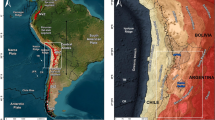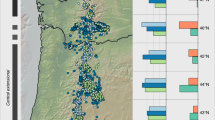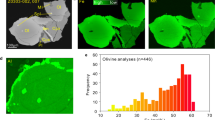Abstract
Arc volcanism arises from the release of fluids from the descending slab, which enables melting in the mantle wedge by lowering the solidus temperature. Metasomatism—compositional alteration by fluids—of the mantle is known to have an important role in magma production in volcanic arcs over long spatial and temporal scales. However, the episodic eruption of individual arc volcanoes is generally thought to be regulated primarily by the evolution and recharge of crustal magma reservoirs, with no established link to mantle processes. Here we show a link between eruptive activity in the 1999–2016 eruption sequence of Tungurahua volcano in Ecuador and small-scale metasomatism of the magma source. From high-resolution time series of the Pb and Sr isotopic composition of ashes, we determine that during the eruption sequence, the average rate of magma production varies logarithmically with the degree of source metasomatism, and that the sequence ended because of the exhaustion of the metasomatized source during its final weeks. Such an association points to mantle metasomatism over short spatial and temporal scales regulating magma production and ultimately eruptive activity of Tungurahua volcano. The influence of metasomatism on individual eruptions has been recognized for basaltic shield volcanoes, but our findings suggest that it is also a plausible mechanism to produce long-lasting eruptions at andesitic arc volcanoes.






Similar content being viewed by others
Data availability
All data generated during this study are included in this published article (and its Supplementary Information files). Data are also available from the EarthChem repository (https://doi.org/10.26022/IEDA/112767).
References
Cashman, K. V., Sparks, R. S. J. & Blundy, J. D. Vertically extensive and unstable magmatic systems: a unified view of igneous processes. Science 355, eaag3055 (2017).
Rutherford, M. J., Sigurdsson, H., Carey, S. & Davis, A. The May 18, 1980, eruption of Mount St. Helens. 1. Melt composition and experimental phase equilibria. J. Geophys. Res. 90, 2929–2947 (1985).
Moore, G. & Carmichael, I. S. E. The hydrous phase equilibria (to 3 kbar) of an andesite and basaltic andesite from western Mexico: constraints on water content and conditions of phenocryst growth. Contrib. Mineral. Petrol. 130, 304–319 (1998).
Andujar, J., Scaillet, B., Pichavant, M. & Druitt, T. H. Differentiation conditions of a basaltic magma from Santorini, and its bearing on the production of andesite in arc settings. J. Petrol. 56, 765–794 (2015).
Ginibre, C., Wörner, G. & Kronz, A. Crystal zoning as an archive for magma evolution. Elements 3, 261–266 (2007).
Morgan, D. J. et al. Time scales of crystal residence and magma chamber volume from modelling of diffusion profiles in phenocrysts: Vesuvius 1944. Earth Planet. Sci. Lett. 222, 933–946 (2004).
Turner, S. & Costa, F. Measuring timescales of magmatic evolution. Elements 3, 267–272 (2007).
Corsaro, R. A. & Pompilio, M. Magma dynamics in the shallow plumbing system of Mt. Etna as recorded by compositional variations in volcanics of recent summit activity (1995–1999). J. Volcanol. Geotherm. Res. 137, 55–71 (2004).
Turner, S. J., Izbekov, P. & Langmuir, C. The magma plumbing system of Bezymianny volcano: insights from a 54 year time series of trace element whole-rock geochemistry and amphibole compositions. J. Volcanol. Geotherm. Res. 263, 108–121 (2013).
Annen, C., Blundy, J. D. & Sparks, R. S. J. The genesis of intermediate and silicic magmas in deep crustal hot zones. J. Petrol. 47, 505–539 (2006).
Till, C. B. et al. The causes of spatiotemporal variations in erupted fluxes and compositions along a volcanic arc. Nat. Commun. 10, 1350 (2019).
Colucci, S. & Papale, P. Deep magma transport control on the size and evolution of explosive volcanic eruptions. Front. Earth Sci. 9, 681083 (2021).
Champenois, J. et al. Large-scale inflation of Tungurahua volcano (Ecuador) revealed by persistent scatterers SAR interferometry. Geophys. Res. Lett. 41, 5821–5828 (2014).
Muller, C. et al. Temporal evolution of the magmatic system at Tungurahua volcano, Ecuador, detected by geodetic observations. J. Volcanol. Geotherm. Res. 368, 63–72 (2018).
Bablon, M. et al. Eruptive chronology of Tungurahua volcano (Ecuador) revisited based on new K–Ar ages and geomorphological reconstructions. J. Volcanol. Geotherm. Res. 357, 378–398 (2018).
Nauret, F. et al. The genetic relationship between andesites and dacites at Tungurahua volcano, Ecuador. J. Volcanol. Geotherm. Res. 349, 283–297 (2018).
Hall, M. L., Robin, C., Beate, B., Mothes, P. & Monzier, M. Tungurahua volcano, Ecuador: structure, eruptive history and hazards. J. Volcanol. Geotherm. Res. 91, 1–21 (1999).
Le Pennec, J.-L. et al. The AD 1300–1700 eruptive periods at Tungurahua volcano, Ecuador, revealed by historical narratives, stratigraphy and radiocarbon dating. J. Volcanol. Geotherm. Res. 176, 70–81 (2008).
Le Pennec, J.-L. et al. Impact of tephra falls on Andean communities: the influences of eruption size and weather conditions during the 1999–2001 activity of Tungurahua volcano. Ecuad. J. Volcanol. Geotherm. Res. 217–218, 91–103 (2012).
Wright, H. M. N. et al. Estimating rates of decompression from textures of erupted ash particles produced by 1999–2006 eruptions of Tungurahua volcano, Ecuador. Geology 40, 619–622 (2012).
Arellano, S. R. et al. Degassing patterns of Tungurahua volcano (Ecuador) during the 1999–2006 eruptive period, inferred from remote spectroscopic measurements of SO2 emissions. J. Volcanol. Geotherm. Res. 176, 151–162 (2008).
Samaniego, P., Le Pennec, J. L., Robin, C. & Hidalgo, S. Petrological analysis of the pre-eruptive magmatic process prior to the 2006 explosive eruptions at Tungurahua volcano (Ecuador). J. Volcanol. Geotherm. Res. 199, 69–84 (2011).
Eychenne, J., Le Pennec, J. L., Ramon, P. & Yepes, H. Dynamics of explosive paroxysms at open-vent andesitic systems: high-resolution mass distribution analyses of the 2006 Tungurahua fall deposit (Ecuador). Earth Planet. Sci. Lett. 361, 343–355 (2013).
Myers, M. L. et al. Replenishment of volatile-rich mafic magma into a degassed chamber drives mixing and eruption of Tungurahua volcano. Bull. Volcanol. 76, 872 (2014).
Hidalgo, S. et al. SO2 degassing at Tungurahua volcano (Ecuador) between 2007 and 2013: transition from continuous to episodic activity. J. Volcanol. Geotherm. Res. 298, 1–14 (2015).
Ancellin, M.-A. et al. Across-arc versus along-arc Sr–Nd–Pb isotope variations in the Ecuadorian volcanic arc. Geochem. Geophys. Geosyst. 18, e2016GC006679 (2017).
Straub, S. M. et al. Formation of hybrid arc andesites beneath thick continental crust. Earth Planet. Sci. Lett. 303, 337–347 (2011).
Narvaez, D., Rose-Koga, E., Samaniego, P., Koga, K. & Hidalgo, S. Constraining magma sources using primitive olivine-hosted melt inclusions from Puñalica and Sangay volcanoes (Ecuador). Contrib. Mineral. Petrol. 173, 80 (2018).
Smith, D. J. Clinopyroxene precursors to amphibole sponge in arc crust. Nat. Commun. 5, 4329 (2014).
Chiaradia, M., Müntener, O., Beate, B. & Fontignie, D. Adakite-like volcanism of Ecuador: lower crust magmatic evolution and recycling. Contrib. Mineral. Petrol. 158, 563–588 (2009).
Bourdon, E. et al. Magmatic response to early aseismic ridge subduction: the Ecuadorian margin case (South America). Earth Planet. Sci. Lett. 205, 123–138 (2003).
Le Voyer, M., Rose-Koga, E. F., Laubier, M. & Schiano, P. Petrogenesis of arc lavas from the Rucu Pichincha and Pan de Azucar volcanoes (Ecuadorian arc): major, trace element, and boron isotope evidences from olivine-hosted melt inclusions. Geochem. Geophys. Geosyst. 9, e2008GC002173 (2008).
Hidalgo, S. et al. Adakitic magmas in the Ecuadorian volcanic front: petrogenesis of the Iliniza volcanic complex (Ecuador). J. Volcanol. Geotherm. Res. 159, 366–392 (2007).
Samaniego, P., Robin, C., Chazot, G., Bourdon, E. & Cotten, J. Evolving metasomatic agent in the northern Andean subduction zone, deduced from magma composition of the long-lived Pichincha volcanic complex (Ecuador). Contrib. Mineral. Petrol. 160, 239–260 (2010).
Pietruszka, A. J., Rubin, K. H. & Garcia, M. O. 226Ra–230Th–238U disequilibria of historical Kilauea lavas (1790–1982) and the dynamics of mantle melting within the Hawaiian plume. Earth Planet. Sci. Lett. 186, 15–31 (2001).
Vlastélic, I. et al. Control of source fertility on the eruptive activity of Piton de la Fournaise volcano, La Réunion. Sci. Rep. 8, 14478 (2018).
Andújar, J. et al. Structure of the plumbing system at Tungurahua volcano, Ecuador: insights from phase equilibrium experiments on July–August 2006 eruption products. J. Petrol. 58, 1249–1278 (2017).
Koch, C. D. et al. Crustal thickness and magma storage beneath the Ecuadorian arc. J. South Am. Earth Sci. 110, 103331 (2021).
Kelemen, P. B., Shimizu, N. & Salters, V. J. M. Extraction of mid-ocean-ridge basalt from the upwelling mantle by focused flow of melt in dunite channels. Nature 375, 747–753 (1995).
Keller, T. & Katz, R. F. The role of volatiles in reactive melt transport in the asthenosphere. J. Petrol. 57, 1073–1108 (2016).
Müntener, O., Kelemen, P. B. & Grove, T. L. The role of H2O during crystallization of primitive arc magmas under uppermost mantle conditions and genesis of igneous pyroxenites: an experimental study. Contrib. Mineral. Petrol. 141, 643–658 (2001).
Rawson, H. et al. Compositional variability in mafic arc magmas over short spatial and temporal scales: evidence for the signature of mantle reactive melt channels. Earth Planet. Sci. Lett. 456, 66–77 (2016).
Paulatto, M. et al. Dehydration of subducting slow-spread oceanic lithosphere in the Lesser Antilles. Nat. Commun. 8, 15980 (2017).
Ruprecht, P. & Plank, T. Feeding andesitic eruptions with a high-speed connection from the mantle. Nature 500, 68–72 (2013).
Mattioli, M., Renzulli, A., Menna, M. & Holm, P. M. Rapid ascent and contamination of magmas through the thick crust of the CVZ (Andes, Ollagüe region): evidence from a nearly aphyric high-K andesite with skeletal olivines. J. Volcanol. Geotherm. Res. 158, 87–105 (2006).
Marsh, B. D. On the cooling of ascending andesitic magma. Phil. Trans. R. Soc. Lond. A 288, 611–625 (1978).
Albarède, F. Residence time analysis of geochemical fluctuations in volcanic series. Geochim. Cosmochim. Acta 57, 615–621 (1993).
Koulakov, I. et al. Rapid changes in magma storage beneath the Klyuchevskoy group of volcanoes inferred from time-dependent seismic tomography. J. Volcanol. Geotherm. Res. 263, 75–91 (2013).
Moussallam, Y. et al. Fast ascent rate during the 2017–2018 Plinian eruption of Ambae (Aoba) volcano: a petrological investigation. Contrib. Mineral. Petrol. 174, 90 (2019).
Turner, S., Evans, P. & Hawkesworth, C. Ultrafast source-to-surface movement of melt at island arcs from 226Ra–230Th systematics. Science 292, 1363–1366 (2001).
Tamura, Y., Tatsumi, Y., Zhao, D., Kido, Y. & Shukuno, H. Hot fingers in the mantle wedge: new insights into magma genesis in subduction zones. Earth Planet. Sci. Lett. 197, 105–116 (2002).
Vlastélic, I. et al. Probing the hidden magmatic evolution of El Misti volcano (Peru) with the Pb isotope composition of fumaroles. Bull. Volcanol. 84, 17 (2022).
Bustillos, A. J., Romero, J. E., Guevara, C. A. & Díaz-Alvarado, J. Tephra fallout from the long-lasting Tungurahua eruptive cycle (1999–2014): variations through eruptive style transition and deposition processes. Andean Geol. 45, 47–77 (2018).
Bernard, B. Homemade ashmeter: a low-cost, high-efficiency solution to improve tephra field-data collection for contemporary explosive eruptions. J. Appl. Volcanol. 2, 1 (2013).
Deniel, C. & Pin, C. Single-stage method for the simultaneous isolation of lead and strontium from silicate samples for isotopic measurements. Anal. Chim. Acta 426, 95–103 (2001).
Todt, W., Cliff, R. A., Hanser, A. & Hofmann, A. W. in Earth Processes: Reading the Isotopic Code (eds Basu, A. & Hart, S.) 429–437 (Geophysical Monograph Series 95, AGU, 1996).
Workman, R. K. & Hart, S. R. Major and trace element composition of the depleted MORB mantle (DMM). Earth Planet. Sci. Lett. 231, 53–72 (2005).
Bustillos, J., Romero, J., Troncoso, L. & Guevara, A. Tephra fall at Tungurahua Volcano (Ecuador) - 1999–2014: an example of tephra accumulation from a long-lasting eruptive cycle. Geofís. Int. 55, 55–67 (2016).
Bernard, J., Eychenne, J., Le Pennec, J.-L. & Narvaez, D. Mass budget partitioning during explosive eruptions: insights from the 2006 paroxysm of Tungurahua volcano, Ecuador. Geochem. Geophys. Geosyst. 17, 3224–3240 (2016).
Kelfoun, K. & Vallejo, S. VolcFlow capabilities and potential development for the simulation of lava. Geol. Soc. Lond. Spec. Publ. 426, 337–343 (2016).
Yaguana, D. Geomorphological Evolution of the Tungurahua Volcano Crater: Eruptive Period Between 2002 and 2016. PhD thesis, National Polytechnic School (2020); http://bibdigital.epn.edu.ec/handle/15000/21245
Acknowledgements
This work is part of the ‘Laboratoire Mixte International’ programme entitled ‘Seismes et Volcans dans les Andes du Nord’. The research was financed by the Institut de Recherche pour le Développement, the French Government Laboratory of Excellence initiative number ANR-10-LABX-0006, the Region Auvergne and the European Regional Development Fund. This is Laboratory of Excellence ClerVolc contribution number 581. Tungurahua volcano monitoring was supported by Ecuadorian Government Project SENPLADES: Generación de Capacidades para la Emisión de Alertas Tempranas.
Author information
Authors and Affiliations
Contributions
I.V. designed the study, coordinated the analyses and wrote the paper. N.S. performed the isotopic analyses and wrote the paper. P.S. designed the study and contributed to data interpretation. B.B. collected samples and contributed to data interpretation. F.N. and S.H. contributed to the discussions and interpretation of the data. D.A. supervised Sr isotope measurements. A.G. supervised Pb isotope measurements
Corresponding author
Ethics declarations
Competing interests
The authors declare no competing interests.
Peer review
Peer review information
Nature Geoscience thanks Jorge E. Romero, Simon Turner and the other, anonymous, reviewer(s) for their contribution to the peer review of this work. Primary handling editors: Stefan Lachowycz and Rebecca Neely, in collaboration with the Nature Geoscience team.
Additional information
Publisher’s note Springer Nature remains neutral with regard to jurisdictional claims in published maps and institutional affiliations.
Supplementary information
Supplementary Table 1
Sr–Pb isotope composition of juvenile ash samples from the 1999–2016 eruptions of Tungurahua volcano.
Supplementary Table 2
Compositions of the four end-member components used in the mixing model.
Rights and permissions
Springer Nature or its licensor (e.g. a society or other partner) holds exclusive rights to this article under a publishing agreement with the author(s) or other rightsholder(s); author self-archiving of the accepted manuscript version of this article is solely governed by the terms of such publishing agreement and applicable law.
About this article
Cite this article
Vlastélic, I., Sainlot, N., Samaniego, P. et al. Arc volcano activity driven by small-scale metasomatism of the magma source. Nat. Geosci. 16, 363–370 (2023). https://doi.org/10.1038/s41561-023-01143-0
Received:
Accepted:
Published:
Issue Date:
DOI: https://doi.org/10.1038/s41561-023-01143-0
- Springer Nature Limited
This article is cited by
-
A quantitative assessment of crop vulnerability to tephra hazard at Tungurahua volcano, Ecuador: understanding the effect of volcanic and biological factors
Bulletin of Volcanology (2024)
-
Eruptions from the deep
Nature Geoscience (2023)





